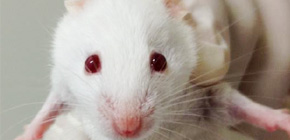
Murine models of atopic dermatitis generated in experiments that cause minimal pain and stress in mice
Will lead to new drug development with high regard for animal welfare
Researchers led by Visiting Professor Tadashi WADA at the Graduate School of Engineering, Osaka University, succeeded in producing murine models of atopic dermatitis (AD) through only two painting sessions of haptens, small-molecular-weight compounds. Simplifying animal model protocols for developing AD-like skin inflammation minimized burden on experimental animals, expanding the possibility of new drug development.
This result was achieved through joint research by the Yoshindo Nucleic Acid Joint Research Chair and the School of Medicine, Nihon University. The Yoshindo Nucleic Acid Joint Research Chair has been operated by the Graduate School of Engineering, Osaka University and Yoshindo Inc. at Osaka University from 2013 to 2018 with the slogan of “Industry on Campus.”
The researchers were able to determine conditions for generating AD model mice using a simple method, significantly reducing the burden on experimental mice compared to conventional methods. Their achievements put emphasis on improvement of the welfare of animals used for drug development.
In experiments, hapten was painted on the dorsal skin of experimental mice on Day 1 and the second dorsal painting was performed two weeks later on the same place. After these two painting sessions, AD-like symptoms, such as scratching behavior and skin lesions, were reproducibly observed.
It is reported that patients with AD have high serum IgE levels and Type 2 helper T (Th2) cell-dominant immune responses.
In this study, the serum IgE level increased in the model mice five days after the second painting session. The histological analysis revealed that the lesions on the dorsal skin were remarkably similar to AD symptoms. Specifically, the researchers observed cavernous transformation and partial disruption of stratum corneum, which were associated with epidermal hypertrophy, and marked mast-cell and lymphocyte infiltration of the dermis. They also observed increased expression of inflammatory cytokines, which shows Th2- dominant immune responses.
These results showed that the group generated model mice with AD-like symptoms by their improved method. The method significantly reduced the burden on the mice compared to conventional methods by reducing the working process to two painting sessions and shortening the period of processing to two weeks.
In drug development, welfare of animals used for experimental purposes should be emphasized as much as possible. This study demonstrated that reviewing experimental protocol reduced the pain and stress of animals used for experimental purposes. It is expected that this group’s study will lead to reviewing of conventional research on laboratory animals.
Abstract
Drug development involves pharmacometric experiments in animals. Such experiments should limit animal pain and stress. Conventional murine models of atopic dermatitis (AD) used in drug development are generated by weekly painting of hapten on dorsal skin for 5 weeks. The present study aimed to develop a protocol that involves less animal distress. The experiments focused on serum total IgE levels, which are a marker of AD. The conventional protocol induced ever rising IgE levels. Experiments with extended intervals between sensitizations showed that IgE peaked ~5 days after the second sensitization, after which it returned to the control level within 12–19 days. An additional third sensitization on day 28 further increased the serum IgE level. In the 4–5 days after the second sensitization, the dorsal skin exhibited typical AD-like lesions with edema, scabs, epithelial-cell hypertrophy, marked mast-cell and lymphocyte infiltration of dermis, and increased IL-4, IL-6, IL-10, IL-1β, IL-17A, IFN-γ and TNF-α expression. Thus, two 2,4-dinitrofluorobenzene sensitizations yield a murine AD model in less than 20 days. This study shows that animal model protocols used in drug development can be fine-tuned so that they remain effective yet cause animals less stress and pain.
Figure 1 . Laboratory mouse
To learn more about this research, please view the full research report entitled " A murine model of atopic dermatitis can be generated by painting the dorsal skin with hapten twice14 days apart " a t this page of Scientific Reports .
Related link

